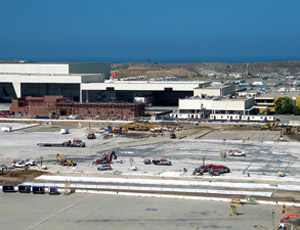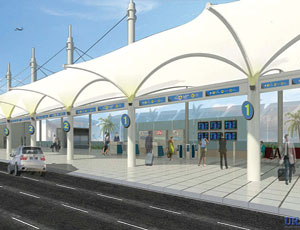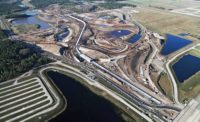Airports in Southern California, one of the nation’s most heavily populated regions, are building as much and as “green” as they can with limited space and tight budgets. Modernization projects at the San Diego, Long Beach and Los Angeles airports are requiring engineers to think creatively.


The San Diego County Regional Airport Authority’s $1-billion green-build program includes a 445,000-sq-ft expansion of Terminal 2 to accommodate 19 gates instead of nine. It also includes two new, 17,000-sq-ft curbside ticket lobbies, called smart curbs, a new transit center, an elevated departure roadway, six overpasses, and new roads and parking lots—all squeezed into a 650-acre space.
“We thought, the climate here is good, so instead of building more ticket lobbies, why not offer full-service check-in outside?” says Steve Cornell, former terminal development program director and now aviation director for the western region at T.Y. Lin International, San Francisco. Doing so shaved 30% off the lobby space for the terminal extension, he says.
A local joint venture of Flatiron Construction Corp., Turner Construction Co. and PCL Constructors Inc. holds a $500- million design-build contract covering both the expansion and 1.5 million sq ft of new taxiways and aprons.
A joint venture of Kiewit Construction Co. and Sundt Construction Inc. holds a $273-million design-build contract for heavy landside civil work. “We’re basically building on a postage-stamp-sized space,” says Bradlee Kirsch, Sundt project manager. “One of the big challenges is trying to create these outdoor pavilions with maximum flexibility for evolving technology, Kirsch adds. The outdoor pavilions will have check-in kiosks, luggage drop-off and flight information.
Kiewit/Sundt this summer demolished a pedestrian bridge in 21 hours to make room for the new elevated road. Crews placed 2 ft of soil on the arrivals road to cushion a baggage tunnel from the impact of demolition. The team also demolished a United Service Organizations facility after building a temporary location for it. Eventually, it will build a 10,000-sq-ft USO facility, says Kirsch.
Los Angeles International Airport may be a lot bigger, but it has space challenges similar to San Diego’s. “We have many large-scale jobs happening at once at a 3,500-acre airport,” says Warren Sprague, aviation core group manager for AECOM, which is providing support services for some $4 billion worth of work, including a $1.5-billion doubling of the international terminal.
To make room for the 1.25-million-sq-ft terminal expansion, other airport components had to be demolished and rebuilt, including a $120-million, 7,000-ft crossfield taxiway and a $11-million, 27,500-sq-ft new firefighting facility. “The old facility was in the way of the new taxiway, so we bumped it out,” says Chris Williams, construction manager for Paragon Project Resources Inc., Irving, Texas, which is providing construction support services on both jobs.
Now a similar taxiway is under construction. “Phasing is difficult,” says Intissar Durham, LAX chief engineer. “We cannot build the north end of the [ongoing] taxiway until the [firefighting facility] is finished. “Every project would be simple on its own, but not here. We’re moving puzzle pieces around.”
LAX recently completed a $730-million renovation of the existing international terminal. “We’ll build new concourses to the west, then expand the core terminal, then demolish the existing concourses,” she says. “We’re pushing everything west.”
In Long Beach, Mario Rodriguez, airport director, is pushing much construction into the future. He says he has adopted a “lean business model” to keep pace with financial realities. A $45-million new concourse, a $56-million, 2,000-space parking structure, a $33-million aircraft pad and a $2-million terminal modernization are part of a deliberately paced program that Rodriguez calls “scalable.”
For example, the original garage plan was for 4,000 spaces, but the airport won’t build them until they are clearly needed, to avoid raising airline fees and debt. “It’s similar to a condo in a half-empty building—you still pay the same fees,” Rodriguez says. “The point is to take a strategic business approach instead of the typical public-works approach.”



Post a comment to this article
Report Abusive Comment